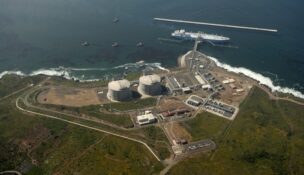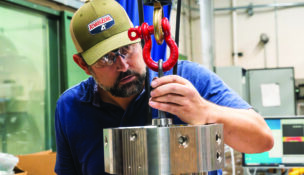Xcel gives new life to historic, clean energy water plant
A hydroelectric generating station with a difficult past is getting a new multi-million dollar lease on life
Julie Kailus //February 27, 2020//


Xcel gives new life to historic, clean energy water plant
A hydroelectric generating station with a difficult past is getting a new multi-million dollar lease on life
Julie Kailus //February 27, 2020//

A hydroelectric generating station with a difficult past is getting a new multi-million dollar lease on life. As part of its commitment to carbon-free electricity by 2050, Xcel Energy is modernizing Cabin Creek, a historic high-altitude, clean-energy water plant near Georgetown. The utility currently sources 27% of its electricity from renewable sources.
Emission-free hydroelectric power is one of the oldest methods of energy generation, accounting for more than 40% of America’s electricity supply in the early 1900s. And with today’s increasing demand for renewable sources, it can’t be overlooked.
Of six hydroelectric plants statewide, Cabin Creek is the only unit using pump storage technology. It’s also Xcel’s largest and most groundbreaking. In 1968, the Edison Electric Institute gave the plant its highest honor, the Edison Award, for novel engineering. But at over 50 years old, the Cabin Creek generating station needs $88 million in infrastructure, including two giant turbine replacements, to function efficiently for the foreseeable future.
“Long recognized as an innovative plant with technology that allows it to store energy, Cabin Creek provides clean, reliable energy for Colorado customers and plays an important role in Xcel Energy’s clean-energy transition,” says John Pierce, principal engineer of the Cabin Creek upgrade.
As Cabin Creek releases water from an upper reservoir, it flows through a 4,300-foot tunnel, turning generators, and recycling water back into the reservoir. Currently two-pump turbines generate 324 megawatts a day. For reference, 1 megawatt can power approximately 750 Colorado homes for one hour.
The Cabin Creek upgrade, which began in mid-2018, includes rebuilding both pump-turbine motor-generator units to improve pumping and generate efficiencies, according to Pierce. This will increase the plant’s capacity to 343 megawatts while reducing its cycle time by more than 15%.
“As we continue adding more wind to our Colorado system, we can store it for later use by timing it with Cabin Creek’s water usage, allowing the plant to store energy, much like a battery, which will help us achieve our carbon-free goal,” Pierce says.
In addition to retrofitting two new giant turbines, the 210-foot upper dam wall was raised 4 feet to increase storage capacity, which was no small feat. Transporting engineering equipment up to 11,200 feet has been a challenge, but one that’s clearly worth it for the amount of clean energy an upgraded Cabin Creek stands to generate.
Georgetown’s Town Administrator Kent Brown says it has been interesting watching 78-foot-long semis carting Xcel equipment up and around the notoriously tight switchbacks on 11,669-foot Guanella Pass in order to avoid town.
While the added commercial traffic has proved challenging during summer months, it slows in the winter, and Brown says Georgetown has been cooperating with Xcel to continue to smooth the process. “It’s good that they are keeping the facility open and running, because it’s one of the few facilities in the state that’s hydroelectric,” Brown says. “It’s a unique thing that we have here.”

High-altitude hydroelectric saga
Indeed, Cabin Creek is an engineering wunderkind. Opened in 1967, it was at the time the highest altitude pumped storage plant in the world. Since then, its turbines have consistently cycled at record-high operating speeds due to the dramatic elevation change between its upper and lower reservoirs. It’s a workhorse for Xcel Energy.
Cabin Creek generates electricity by releasing water from an upper reservoir, through a tunnel, over the turbine generators, and down to a lower reservoir. But its pumped storage capacity is its most interesting element. When there’s less demand or wind energy takes over on the Xcel grid, Cabin Creek can propel water back to the upper reservoir and store it like a big battery for future use.
While a sophisticated model for hydroelectric generation, Cabin Creek has a tragic history. In 2007, a fire at the plant killed five workers after a flammable chemical they were using to clean ignited in a tunnel. A criminal trial in the deaths of the workers ended with a $1.5 million plea agreement in 2011. Two years later, the Colorado Court of Appeals dismissed lawsuits against three companies tied to the incident, including plant owner Xcel Energy.
Brown says Georgetown residents still remember the tragedy but have moved on. The small mountain community, much like Cabin Creek, is in survival mode. With the impending closure of the Henderson Mine, a major extraction-industry employer, Georgetown and surrounding Clear Creek County need the economic boost.
“Cabin Creek has been part of the Georgetown community for more than 50 years, and the improvements made during this upgrade will extend the life of the plant for an additional 40 years, preserving the tax base and other local benefits,” Pierce says. “We see this work as bringing great value to Georgetown and the surrounding area, while demonstrating our commitment to the communities we serve.”
The first new Cabin Creek hydroelectric turbine should begin spinning as early as this month. Once it’s in service, Xcel will begin construction on the second unit, which is scheduled to wrap in early 2021.






















